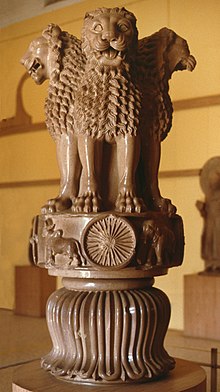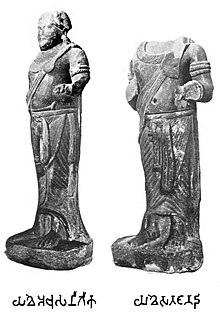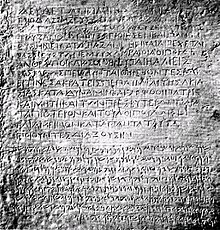Maurya Empire
[j] Through military conquests and diplomatic treaties, Chandragupta Maurya defeated the Nanda dynasty and extended his suzerainty as far westward as Afghanistan below the Hindu Kush and as far south as the northern Deccan;[k] however, beyond the core Magadha area, the prevailing levels of technology and infrastructure limited how deeply his rule could penetrate society.Despite profitable settled agriculture in the fertile eastern Gangetic plain, these factors helped maritime and river-borne trade, which were essential for acquiring goods for consumption as well as metals of high economic value.[n] To promote movement and trade, the Maurya dynasty built roads, most prominently a chiefly winter-time road—the Uttarapath—which connected eastern Afghanistan to their capital Patliputra during the time of year when the water levels in the intersecting rivers were low and they could be easily forded.[11] The empire's period of dominion was marked by exceptional creativity in art, architecture, inscriptions and produced texts,[18] but also by the consolidation of caste in the Gangetic plain, and the declining rights of women in the mainstream Indo-Aryan speaking regions of India.[19] After the Kalinga War in which Ashoka's troops visited much violence on the region, he embraced Buddhism and promoted its tenets in edicts scattered around South Asia, most commonly in clusters along the well-traveled road networks.Neighbouring cultures usually adressed this land by a variety of exonyms, such as the Greek Ἰνδῐ́ᾱ (Indíā, derived from the Indus River), which gave most European languages the common name for the subcontinent, including English.This revolt was led by Chandragupta, who in turn established an oppressive regime himself "after taking the throne":[40][r] India, after the death of Alexander, had assassinated his prefects, as if shaking the burden of servitude.[56][57] In contrast to the easy victory in Buddhist sources, the Hindu and Jain texts state that the campaign was bitterly fought because the Nanda dynasty had a powerful and well-trained army.According to Kosmin, "Seleucus transferred to Chandragupta's kingdom the easternmost satrapies of his empire, certainly Gandhara, Parapamisadae, and the eastern parts of Gedrosia, and possibly also Arachosia and Aria as far as Herat.And Phylarchus confirms him, by reference to some of the presents which Sandrakottus, the king of the Indians, sent to Seleucus; which were to act like charms in producing a wonderful degree of affection, while some, on the contrary, were to banish love.Chandragupta established a decentralised state[a] with an administration at Pataliputra, which, according to Megasthenes, was "surrounded by a wooden wall pierced by 64 gates and 570 towers.According to the medieval Tibetan scholar Taranatha who visited India, Chanakya helped Bindusara "to destroy the nobles and kings of the sixteen kingdoms and thus to become absolute master of the territory between the eastern and western oceans".The famous Tamil poet Mamulanar of the Sangam literature described how areas south of the Deccan Plateau which comprised Tamilakam was invaded by the Mauryan Army using troops from Karnataka.Other historians, such as Etienne Lamotte[116] and Romila Thapar,[117] among others, have argued that archaeological evidence in favour of the allegations of persecution of Buddhists are lacking, and that the extent and magnitude of the atrocities have been exaggerated.Although the extent of their successes against indigenous powers such as the Shungas, Satavahanas, and Kalinga are unclear, what is clear is that Scythian tribes, named Indo-Scythians, brought about the demise of the Indo-Greeks from around 70 BCE and retained lands in the trans-Indus, the region of Mathura, and Gujarat.The coins were widely used for trade and commerce[120] Monica Smith notes that historiography has tended to view ancient states as vast territories, whereas they are better understood as networks of centers of power, a model that also applies to the Maurya Empire.[121] Kulke and Rothermunf agree with her approach, noting that Ashoka's inscriptions reveal a regional pattern, demarcating the five parts of the empire, whereas the major rock edicts have only been found in the frontier provinces, but are absent in the centre.In return the emperor supplied the laborers with agricultural products, animals, seeds, tools, public infrastructure, and stored food in reserve for times of crisis.The village heads (Gramika) and mayors (Nagarika) were responsible enumerating different classes of people in the Mauryan empire such as traders, agriculturists, smiths, potters, carpenters etc.Historians theorise that the organisation of the Empire was in line with the extensive bureaucracy described by Chanakya in the Arthashastra: a sophisticated civil service governed everything from municipal hygiene to international trade.Having renounced offensive warfare and expansionism, Ashoka nevertheless continued to maintain this large army, to protect the Empire and instil stability and peace across West and South Asia.[129] For the first time in South Asia, political unity and military security allowed for a common economic system and enhanced trade and commerce, with increased agricultural productivity.The previous situation involving hundreds of kingdoms, many small armies, powerful regional chieftains, and internecine warfare, gave way to a disciplined central authority.Farmers were freed of tax and crop collection burdens from regional kings, paying instead to a centrally administered and strict-but-fair system of taxation as advised by the principles in the Arthashastra.Chandragupta Maurya established a single currency across India, and a network of regional governors and administrators and a civil service provided justice and security for merchants, farmers and traders.[citation needed] It is also said that just like Ashoka, Samprati sent messengers and preachers to Greece, Persia and the Middle East for the spread of Jainism, but, to date, no evidence has been found to support this claim.Ashoka sent a mission led by his son Mahinda and daughter Sanghamitta to Sri Lanka, whose king Tissa was so charmed with Buddhist ideals that he adopted them himself and made Buddhism the state religion.[citation needed] During the Ashokan period, stonework was of a highly diversified order and comprised lofty free-standing pillars, railings of stupas, lion thrones and other colossal figures.[155] When Ashoka embraced Buddhism in the latter part of his reign, he brought about significant changes in his style of governance, which included providing protection to fauna, and even relinquished the royal hunt.[155] An influential and large Greek population was present in the northwest of the Indian subcontinent under Ashoka's rule, possibly remnants of Alexander's conquests in the Indus Valley region.Tarn, referring to Eratosthenes, states that: "Alexander [...] took away from Iran the parts of these three satrapies which lay along the Indus and made of them separate [...] governments or province; it was these which Seleucus ceded, being districts predominantly Indian in blood.




















 ... (
Yakhe...
for "Yaksha...") are
paleographically
of a later date, circa 2nd century CE
Kushan
.
[
152
]
... (
Yakhe...
for "Yaksha...") are
paleographically
of a later date, circa 2nd century CE
Kushan
.
[
152
]




Mori KingdomMaurya (surname)Maurya (film)Moriya (disambiguation)EmpirePataliputraSanskritMagadhi PrakritBrahmanismJainismBuddhismAjivikismGreek polytheismZoroastrianismDemonym(s)IndianAbsolute monarchyEmperorChandraguptaBindusaraAshokaDasharathaSampratiShalishukaDevavarmanShatadhanvanBrihadrathaIron AgeNanda-Mauryan WarPushyamitra ShungaKarshapanaNanda EmpireArachosiaParopamisadaeParada kingdomAparantaSaurashtra (region)AndhrasKalinga (historical region)Shunga EmpireIndo-Greek KingdomMitra dynasty (Kosambi)Vidarbha kingdom (Mauryan era)SamatataSatavahana dynastyMahameghavahana dynastyPakistanBangladeshAfghanistanHistory of IndiaTimelineMadrasian cultureSoanianBhirranaLahuradewaMehrgarhIndus Valley CivilizationPost Indus Valley Period(Cemetery H Culture)Vedic civilizationKuru kingdomEarly Vedic periodRise of Śramaṇa movementLater Vedic PeriodSpread of Jainism – ParshvanathaSpread of Jainism – MahaviraRise of BuddhismBrihadratha DynastyHaryanka DynastyShaishunaga DynastyNanda DynastyMahajanapadasClassicalMaurya DynastyPandya DynastyShunga DynastyKanva DynastySangam periodKushan DynastyGupta DynastyEarly medievalPallava dynastyChalukya DynastyHarsha's DynastyKarakota DynastyArab InvasionTripartite StrugglePratihara dynastyRastrakuta DynastyPala DynastyChola Dynasty2nd Chalukya DynastyLate medievalDelhi SultanateMamluk DynastyKhalji DynastyTugluq DynastySayyid DynastyLodhi DynastyPandyan EmpireVijayanagaraBengal SultanateMughal DynastySuri DynastyBengal SubahMaratha EmpireCompany RajKingdom of MysoreSikh EmpireThe Great RebellionBritish Raj Independence MovementIndependent IndiaDominion of IndiaRepublic of IndiaTimeline of Indian HistoryDynasties in Indian HistoryEconomic HistoryLinguistic HistoryArchitectural HistoryArt HistoryLGBT historyLiterary HistoryPhilosophical HistoryMusical HistoryEducation HistoryCoinage History
